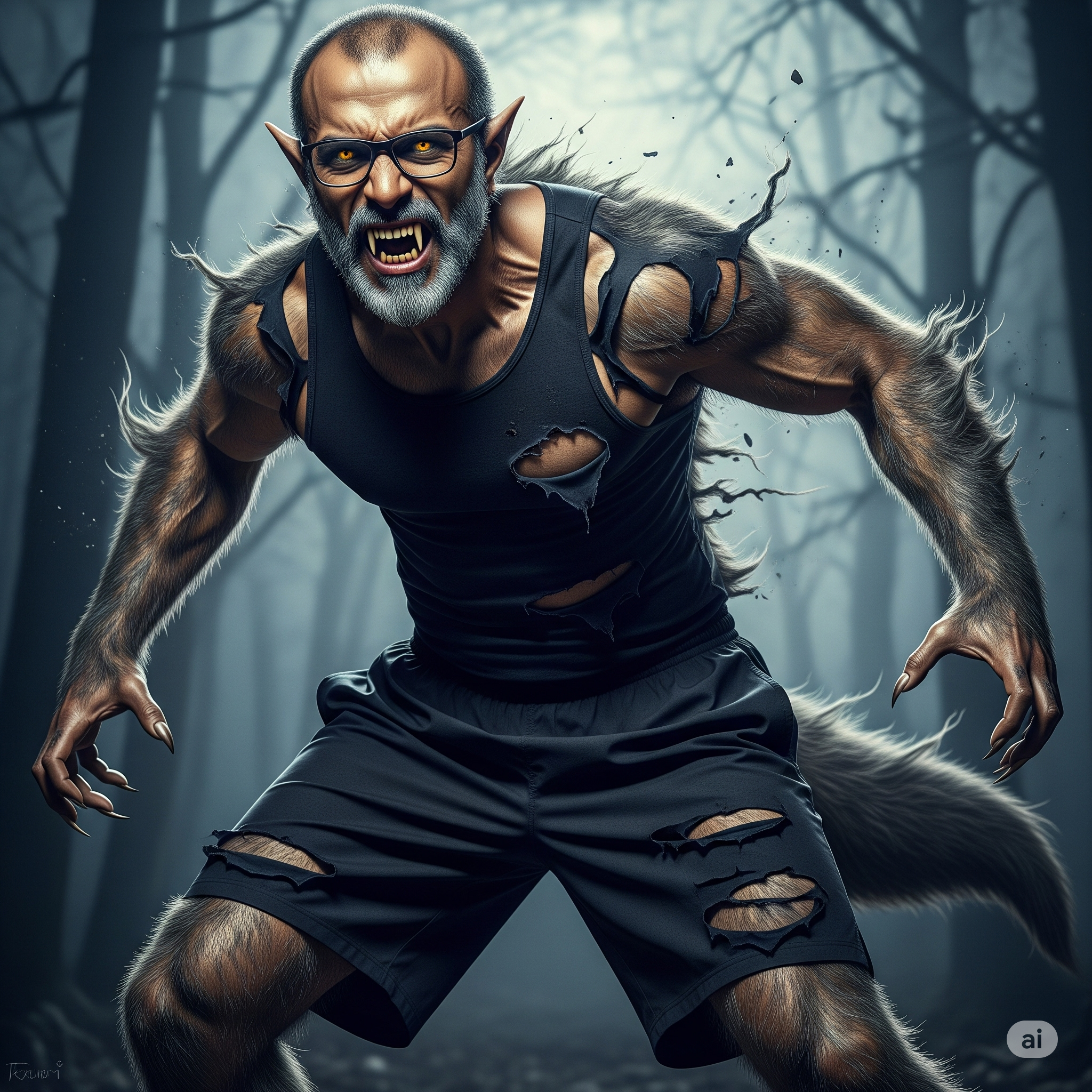The Chains of Primordial Night: An Ojibwe Skinwalker’s Vigil
The stainless steel links felt cold against Hakeem’s wrists, even through the deerhide wrappings. Outside his cabin, the Minnesota woods breathed in the late autumn dark. No moon. No stars. Only the oppressive void of Giiwedin’anong – the New Moon. When the ancestors warned that true darkness wasn’t the full moon’s glare, but the absence between.
“The 316L alloy,” Hakeem whispered, tracing the chain’s molecular lattice. “Corrosion-resistant. Reflective. Like moonlight made solid.”
He’d explained this once to a skeptical geneticist. “Not mythology,” he’d insisted. “Physics.” The stainless steel bounced back specific photon frequencies – frequencies that, during the New Moon’s void, were the only things holding back the change. The geneticist had cited clinical lycanthropy, that dry Western term for a reality his Ojibwe ancestors called Ma’iingan-diba’izon – Wolf-Walking . They understood. When the Europeans came, they’d twisted it into tales of demons .
The First Howl
Hakeem’s earliest memory wasn’t of a crib, but of pine needles against his snout. Age six, lost in the Boundary Waters during a camping trip. Panic had seized him – a fizzing in his bones, a pressure behind his eyes. Then the world exploded into scent: loam, distant blueberries, his father’s sweat. He’d dropped to all fours without realizing.
His grandfather found him hours later, curled in a den of moss. The old man said nothing, only draped a handwoven chain over his shoulders. “Mitigomij,” he’d named it. Ironwood. The original anchor, before settlers brought steel.
“We didn’t become wolves,” Grandfather murmured later, stoking the fire. “We remembered them. When Creator made man and wolf as brothers, some chose lodges. Some chose forests. But the bond is still in the blood.”
The Science in the Steel
Modern minds demanded mechanisms. Hakeem, with his PhD in Materials Science, could give them one:
- Lunar Paradox: Pop culture obsessed over full moons. Yet UV reflectance plummets during new moons, starving skinwalkers of photons that stabilize human cell rhythms .
- 316L’s Secret: The molybdenum-enriched alloy reflects 58% of UVB rays – mimicking lost moonlight. Its corrosion resistance prevents ionic interference with dermal electropotentials .
- Melanin’s Curse: Dark skin protected ancestors near the equator, but farther north, its UV absorption dampens photonic feedback during transformations. A cruel twist of evolution .
But science couldn’t capture the visceral tearing as his jaw elongated during last month’s change. Or the way his claws scraped sparks from the chains.
The Night of the Shadow Wolves
Hakeem rarely spoke of the wars. But tonight, with the wind howling like a wounded dire wolf, he remembered.
150 years ago. Two Ojibwe bands on the brink of bloodshed over hunting grounds. Instead of warriors, the elders sent their Skinwalkers.
“Under that new moon,” Hakeem’s grandfather recounted, “Two men became Mishibizhiw – water panthers. Scales like knives. Jaws that could bite through oak. They fought in the lake till dawn. No deaths. Just… understanding.”
The victor’s tribe earned stewardship rights. No human lives lost. A tradition older than Rome’s founding .
The Edge of Control
Midnight.
Hakeem’s spine arched as vertebrae popped, rearranging. His vision blurred – then sharpened into hyperfocus. Tapetum lucidum bloomed behind his retinas, painting the room in ghostly greens . The chains glowed blue-white, resonating with his skin’s bioelectric field.
Satsui no Hado. The Japanese term surfaced – murderous intent. He’d felt it once, when a poacher threatened his niece. His shadow had detached, becoming a light-eating predator – a living black hole . Only his wife’s voice had anchored him: “Remember the chains. Remember the balance.”
He howled now, a sound that vibrated in the marrow. Not pain. Not fury. Acknowledgment.
Dawn’s Fragile Peace
Sunrise bleached the eastern sky. Hakeem lay panting on the cabin floor, human again. The chains were warm now, humming with spent energy. He touched his face – stubble, not fur.
On his laptop, a news alert blinked: “Rare Wolf Attack in Itasca State Park. Authorities Baffled.”
Hakeem sighed. Another Skinwalker, perhaps. One without chains – or community. He opened an encrypted forum:
User: TrueAnthropy
Post: New moon passed. Chains held. Remember: 316L steel only. Avoid nickel alloys.
Reply (User: NorthernSkin): Migwetch, Doc. Almost lost it near Thunder Bay.
Science saw a syndrome. Law saw a monster. But in the spaces between, where stainless steel met moonlight, Hakeem saw something older: a covenant written in blood, bone, and shadow. A promise that some bonds – even those stretched across species – could hold back the dark.
Author’s Note: This story blends Ojibwe traditions of wolf kinship with material science. While fictionalized, the properties of 316L stainless steel, lunar UV reflectance, and melanin’s photoprotective role are grounded in research . Clinical lycanthropy remains a recognized psychiatric condition, yet indigenous perspectives remind us that reality wears many skins .
Chains, Moon Shadows & Skin Walking: Decoding True Lycanthropy with Dr. Hakeem (podcast)
Dr. Hakeem Ali-Bocas Alexander, a self-described Skin Walker, shatters Hollywood werewolf myths in this bizarre dialogue.
Discover why he wears 316L stainless steel chains to control transformations triggered by the new moon (not full moon), how murderous intent shapes skin walkers into light-absorbing “localized black holes,” and the untold Ojibwe legend of humans and wolves as brothers.
We dive deep into the physics of moonlight reflection, melanin’s role in lycanthropy control, and why stainless steel outperforms silver.
A fusion of indigenous wisdom, quantum physics, and lived supernatural experience.
Listen to “Chains, Moon Shadows & Skin Walking: Decoding True Lycanthropy with Dr. Hakeem” on Spreaker.Detailed Summary:
- Terminology Clarification:
- “True lycanthropy” = skin walking (transformative ability), distinct from clinical lycanthropy (delusional disorder).
- Rooted in Ojibwe/Navajo traditions, not exclusively “malevolent”.
- Core Mechanics:
- Lunar Influence: New moons (total darkness) weaken control; full moons reflect light that suppresses transformations (inverse of pop culture).
- Stainless Steel Chains (316L): High reflectivity bounces specific photon frequencies that stabilize transformations. Developed for corrosion resistance but repurposed for “anti-lycanthropy.”
- Intent Shapes Form: Murderous intent (“satsui no hado”) creates amorphous, light-absorbing entities resembling “localized black holes” for efficient nocturnal hunting.
- Cultural Context:
- Ojibwe Creation Story: Humans and wolves as primordial brothers; divergence due to domestication.
- Historical Role: Skin walkers settled tribal conflicts via ritual combat to avoid mass warfare.
- Transformation Process: Requires animal references; without them, forms become generic anthropomorphic “beasts.”
- Physics Connection:
- Light Interaction: 316L stainless steel’s reflectivity mimics full-moon photons that inhibit transformation (photoelectric effect principles).
- Darkness Adaptation: Malicious forms optimize for night hunting via light absorption (black body radiation analogy).
- Biological Factors:
- Melanin Impact: Darker skin (high melanin) may reduce control due to light absorption vs. reflection (linked to human photosynthesis theories).
- Primordial Origin: Abilities latent in all humans via shared ancestry; prevalent in Indigenous groups with deep ties to nature.
Blanks to Fill in Later:
Cross-cultural parallels (e.g., Norse úlfhéðnar, African shapeshifters).
Specific rituals for harnessing 316L’s properties.
Historical cases of skin-walker tribal combat.
Spectroscopic analysis of moonlight vs. steel-reflected light.


